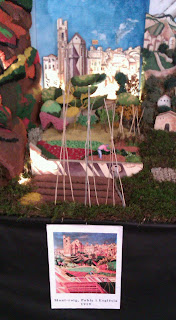Chris and Marta drove us all the short distance from
Cambrils to Montroig del Camp yesterday so we could all take a look at the Joan Miro museum, enjoy a very well priced lunch, and head out on a walk to a most precarious Ermita.
Joan Miro first went to Montroig in 1911, recuperating from illness brought on by harsh working conditions as an apprentice. His family owned an estate near the village and Miro soon came to love the rural lifestyle, returning there every summer for sixty-five years. A museum in his honour, the
Centre Miro, was opened in the disused church of St Michael in 2004. It displays a number of reproductions of his locally painted works along with relevant artefacts and a video interview with the artist himself. As the building itself dates from 1194, it is also interesting in its own right and has a beautiful ceiling and rose window.
Centre Miro costs €3 for adults (€2 for pensioners) and is
 |
| Miro painting model |
certainly worth this much! It doesn't just have Miro. At the moment there is also a fascinating section dedicated to photographs of the barraques which are five restored stone-built traditional huts. The craftsmanship needed to build a barraque is amazing. My favourite displays were the wonderfully detailed models. There are half a dozen three dimensional recreations of Miro paintings lined up in the foyer. One is pictured here and I liked it because it includes a row of intertwined tomato plant canes which, we learned, were Miro's inspiration for his often used star motifs. Another large model actually inside the museum showed the whole village, complete with details such as vegetables growing in little allotments and washing hung out to dry on roof terraces. One street surface was even covered with a replica of a Miro design - we also learned that his famous bold abstracts are reproduced in coloured wood shavings along Montroig's streets during their annual Miro festival.
 |
| Montroig village model |
The tallest building in the above model is the new church
 |
| Mural inside St Miquel |
dedicated to St Miquel Arcangel de Mont-roig del Camp. We were lucky to be passing the real version at a time when its doors were open so took the opportunity to look inside. It's fabulously decorated yet remarkably restrained by Spanish Catholic standards. There was hardly any gilt and the altar statue of St Miquel was made from natural wood. Most of the walls are covered with murals all showing religious scenes, but with the people painted in a very modern style. A cross-shaped stained glass window had large panes in solid colours - pinks and blues, which produced a stunning effect on the inside walls and the overall atmosphere was tranquil and serene.
After a €9.50 all in Menu Del Dia lunch, we were almost too
 |
| Ermita Mare de Deu de la Roca |
stuffed to attempt walking to the Ermita Mare de Deu de la Roca. In the photo to the right you can see it as the white square perched at the very edge of its rocky outcrop! It didn't feel a lot safer once we were up there! The walk from Montroig only took about an hour and was mostly a reasonably gradual incline along the New Road. The rocks are a stunning red colour, the colour from which the town takes its name, and I was intrigued by their curved erosion patterns where water has flowed through in the past. The effect is almost like that of a sponge and is said to be a possible inspiration for some of Gaudi's architectural creations.
 |
| Montroig red rock |
Once up at the Ermita and its sanctuary, the views out across the Costa Dourada and out to sea are spectacular. Our luck also brought us a remarkably clear non-hazy day. I am pleased with this photo of Dave taken from the Ermita entrance patio. There is a flight of stone steps in front of him, but it appears that the cliff just falls away!
-->






